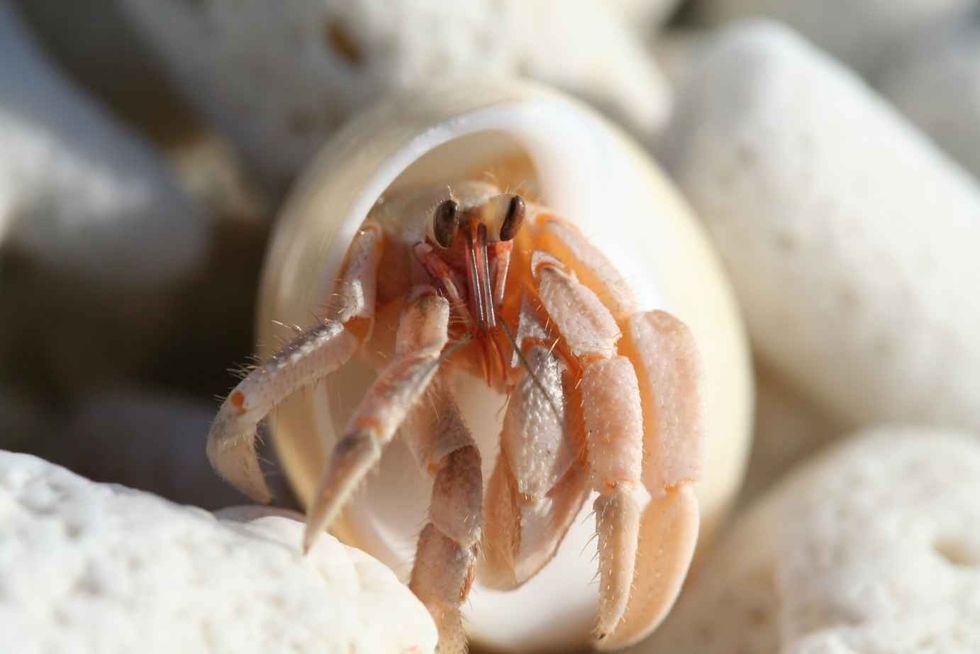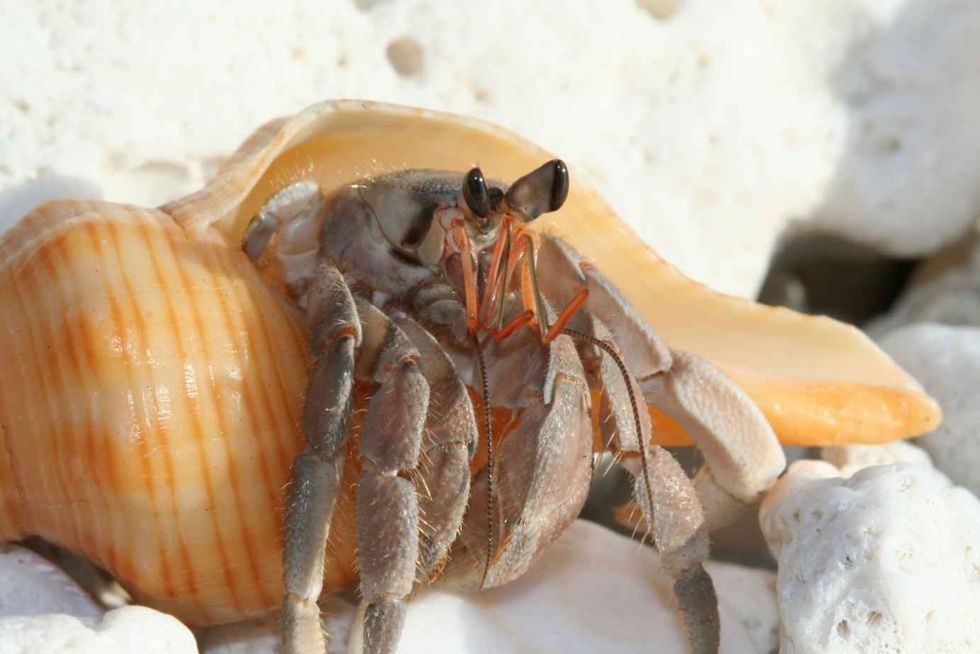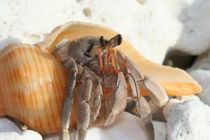Hermit Crab Molting: How To Carefully Care For Your Captive Crab
The hermit crab is a small, beautiful crustacean species known for its exoskeleton and the beautiful shells it wears throughout its lifetime.
Hermit crabs have been named after their ability to protect themselves, specifically their abdomen, from predators and natural calamities using crabs or other animals' shells. They also have two antennae on the front of their body.
The hermit crab belongs to the class of Malacostraca and has many families under the title. Hermit crabs are a native species of the Indo-Pacific region.
The habitat of the hermit crab varies from coastal areas to muddy areas around the sea.
Hermit crabs can be found in temperate, tropical, and subtropical areas of the Northern Hemisphere. Hermit crabs are also known to steal the shells of other small crustaceans, such as snails, and they are also known to molt their exoskeletons or hard shells.
Hermit crabs are good at socializing and are known to search for food in teams. Generally, a hermit crab is known to live for a minimum of 10 years, but some species can also live up to 70 years in a wild environment.
The hermit crab has more than 800 species, and each species' lifestyle varies from the other. On a general level, research done on hermit crabs regarding their conservation status shows that only the coconut crab species is listed as Endangered by the IUCN.
Hermit crab species are known to engage in fights with their prey to take over their shells or look for a protective shell inside of which they can hide their moist and soft body parts.
They must protect their abdomens when molting their exoskeleton's hard shell. They dig in moist soil, bury, and isolate themselves during the molting or shedding process.
The digging sometimes goes deep into the sand surface to protect themselves from high tides. The stress level or stressful behavior of the molted crab is comparatively high in comparison to the state when they have their hard exoskeleton.
When enough substrate is not provided to a crab, if kept in a tank as a pet, then you might see them molting on the surface of the substrate because they are not buried completely.
In a wild environment, when molting begins on the moist sand surface, the scavengers might hunt them down easily.
The ability of hermit crabs to live on land, as well as, in water makes them a semi-aquatic crab species. The freshly molted predators have a strange smell and look weaker, along with having less mobility around the place they live.
Hermit crabs are also known to maintain the ecology of nature around sandy coastal areas because their shells are made up of calcium. Not only that, but their habit of stealing other animals' shells also helps to enrich the soil as they dig deep burrows.
The temperature of their wild environment in nature affects the crab's body a lot as hermit crabs are cold-blooded animals.
If you enjoy reading this article about the hermit crab exoskeleton and hermit crab molting, then do read some other interesting and surprising fun facts about hermit crab out of shell and hermit crab and snail shell relationship.
How long do hermit crabs take to molt?
A hermit crab takes around four to eight weeks to molt its exoskeleton. A hermit crab goes through four stages of molting its exoskeleton.
The four different stages of a hermit crab molting its exoskeleton are prior preparedness for molting, shedding of the exoskeleton, re-growing the hard exoskeleton, and last, time to recover. Throughout the process of shedding and re-growing the shell, the hermit crab is very stressed, and there is aggressive behavior observed in the species.
The molting period varies with each hermit crab's size. The larger the hermit crab is, the longer it takes them to molt their shells.
An average-sized crab will spend four to eight weeks in each of the hermit crab's four stages. The hermit crab spends its time under the sand in isolation. When they begin to molt, they are seen engaged in digging in the substrate to give a shield to their soft, weak limbs and skin.
The buried hermit crab is sometimes confused as dead, but they do not come out of their burrow just to shield themselves. Even land hermit crabs molt at around the same time period and can begin to molt on the surface.
A two-month period for molting is expected to be taken by a medium-sized hermit crab. You must check out the hermit crab if it is kept in a tank within a few time intervals.
Hermit crabs must be kept in an isolation tank if you observe them molting in the tank. Molting is stressful, and this stress leads to aggression. Interrupting them might also lead to their death.
An isolation tank is the best place with the correct calcium substrate sand for digging and burrowing themselves. A small hermit crab molts in a minimum time period of one to two weeks.
What do you do when your hermit crab is molting?
A hermit crab molts once in 18 months. So, it is their natural process and, once your pet hermit crab has molted or is in the process of molting, it is best to leave them on their own.
Give them their own space to molt their shell, provide a proper substrate with calcium and vitamins, a dark place for the secretion of molting hormones, and a proper marine dish or food that they can eat.
The very first thing you need to do is keenly observe the signs of hermit crab molting. If you observe even a single sign of these crabs molting a shell, then leave them in their own space without touching them.
If you interrupt them, then they might be more stressed out because of the molting process, as well as your interruption.
Secondly, once the signs are observed, such as being lethargic and burrowing in the sand substrate or dark places, then try to provide them with the proper food that they eat. This should be done prior to the process starting.
Once their shell molts, then they will become inactive due to muscle and body weakness. These crabs try to hide away from other species if kept with other crabs.
Third, in addition to food, proper calcium and vitamins should be included in their diet, as well as a substrate to provide them with energy and a natural environment.
Fourth, insulation and darkness are regarded as providing encouragement to molting hormones, so this should also be taken into consideration. Also, check the water temperature and its humidity along with the substrate.
It is advised that once hermit crabs molt, they do not require a big tank size. All they need is a deep, calcium-rich dark substrate that can provide them with their natural habitat to bury themselves in.
Provide them with enough water dishes and fruits, as they are an omnivorous water species.
The water should be provided in enough amounts in the tank to meet their natural requirements during the molting process. You can also dig a burrow with the help of a large cylindrical bottle, but this should be done with caution and prior understanding.

How do I know if my hermit crab is molting?
There are certain signs which are shown by a hermit crab prior to molting.
They will become more lethargic and tiresome, along with their antennae being tangled. Their shell color changes to ashy brown, and even their limbs are seen regenerating with a gel-like texture.
You will also see that they engage themselves in the digging process so that they can bury themselves in a dark and insulated area with proper vitamins and calcium. If served with food, then they can be seen eating more at night.
This is done because they become inactive during the period of molting and have to otherwise starve, eventually leading to their death.
Prior to molting, they eat and store food in a fat form on the left side of their stomach in a bubble near their fifth limb pair; then they utilize the same stored food in the fat form to quench their hunger for food and water.
They isolate themselves from other shell species if kept with many other crabs.
In the case of excessive smell, you should check them out to see if they are dead or not. Unless you smell anything bad, it is advised to relax, wait for a couple of weeks or more, do not dig them up, or try to force-feed them because they eat prior to the molting process.
Signs Of Impending Molting
Digging, eating, regenerating each limb, being lethargic, and having dull eyes are some of the signs of impending molting.
The molting process is full of stress and certain behavior changes are seen in hermit crabs.
A hermit crab molts for a time period of two to four or four to eight weeks, depending upon its size.
The very first sign that you can observe in hermit crabs is that they dig the tank substrate, or if you see them by water bodies in coastal line areas, then with each claw they dig the sand and burrow into the substrate or moist soil.
A hermit crab molts in the most accurate temperature and darkness for the secretion of molting hormones.
The temperature affects them a lot, so the humidity level of the water and moist sand humidity must be accurately checked.
The second major sign of the molting process is eating a lot of food. A hermit crab is known to eat food along with storing water to retain its energy for a longer period of time.
Hermit crabs can be seen eating a lot, especially during the night, and scientists believe hermit crabs store their food prior to molting in the left side of their stomach called the bubble, which is later utilized as food in fat form.
The third sign is the regrowth of each limb or claw. Prior to hermit crabs burying themselves, their pairs of limbs can be seen missing and re-growing again.
The crab's limbs appear to be gel-like in texture at the beginning and later develop into a stronger body. Even the antennae of a crab become less active. Aside from that, land hermit crabs or hermit crabs have an odor.
They are more lethargic with weak and dull protruding eyes. The exoskeleton of these turns more brownish in color, and they even isolate themselves.
Do hermit crabs look dead when they molt?
Only the smell of this shell species can help out in knowing whether this species is dead or alive.
Generally, hermit crabs look very lazy, lethargic, and inactive during the process of molting. The body of a hermit crab often removes itself from the shell, so this must cause them some pain.
So, it must be very natural for you to think that they have died, but it is not always the case. Once every 18 months, hermit crabs molt their shells. So, it must be a very new thing if you own a hermit crab as your pet.
However, if it is a new pet, then you must not be worried.
Even if you want to know whether they are dead or molting, just relax, wait for a couple of weeks, and ultimately, by the end, you will come to know whether they are dead or molting through a bad smell.
When they are molting, there is a certain alluring smell that might attract other crabs, but if the crab is dead, then a bad rotten smell is spread all around the tank, making it unbearable.
Remember to never touch a molting hermit crab.
Ways To Care For A Molting Hermit Crab
The best thing you can do, in simple words, is to provide your pet with privacy during the process. When a hermit crab molts, either in a tank or in its natural habitat, it just needs to be left alone.
First, you should know if a hermit crab molt is taking place or not. Prior knowledge of the molting process is a must, whether it is land hermit crabs or not.
A proper environment should be provided to the hermit crab without making things stressful. Excessive digging, a large intake of water and food, and limb regeneration should be noticeable. Apart from that, try to provide them with proper nutrients and vitamins, such as calcium supplements.
Adding large and small shells to the tank is also good for the process of hermit crab molting. As they can protect themselves under these shells, try to keep many minerals in the substrate, such as vitamins and minerals, along with a water dish and food.
It is also advised to not touch hermit crabs along with a shell, as detaching them might eventually lead to their death or might hurt them.
Provide them with a proper, dark place to bury themselves in. If you are not isolating hermit crabs during the molting process in the tank, then other crabs might scavenge on these crabs due to their alluring smell.
If enough substrate is not provided during the molt, then they will no doubt molt on the surface of the substrate, such as in the case of land hermit crabs.
The way you care for any other family member, you should also take this shell species into consideration. You can also use a big-sized cylindrical bottle to help dig a burrow, but this should be done with prior knowledge and the utmost care.
Here at Kidadl, we have carefully created lots of interesting family-friendly facts for everyone to enjoy! If you liked our suggestions for 'Hermit crab molting', then why not take a look at 'Largest crab in the world' or 'Hermit crab fun facts for kids'?
We Want Your Photos!
More for You
Bachelor of Arts specializing in English, Bachelor of Education specializing in Secondary Education and Teaching, Master of Arts specializing in English

Anamika BalouriaBachelor of Arts specializing in English, Bachelor of Education specializing in Secondary Education and Teaching, Master of Arts specializing in English
Bachelor of Commerce specializing in Marketing and HR

Pradhanya RaoBachelor of Commerce specializing in Marketing and HR
With a Bachelor’s degree in Commerce from Christ University, Bangalore, Pradhanya's passion for the English language and literature led her to explore the field of content writing, where she has gained extensive experience in writing, reviewing, editing, and fact-checking. She has also earned certifications in Google Ads Search, Google Ads Display, and Social Media Marketing, showcasing her proficiency in digital marketing.
Disclaimer
1) Kidadl is independent and to make our service free to you the reader we are supported by advertising. We hope you love our recommendations for products and services! What we suggest is selected independently by the Kidadl team. If you purchase using the Buy Now button we may earn a small commission. This does not influence our choices. Prices are correct and items are available at the time the article was published but we cannot guarantee that on the time of reading. Please note that Kidadl is a participant in the Amazon Services LLC Associates Program, an affiliate advertising program designed to provide a means for sites to earn advertising fees by advertising and linking to Amazon. We also link to other websites, but are not responsible for their content.
2) At Kidadl, we strive to recommend the very best activities and events. We will always aim to give you accurate information at the date of publication - however, information does change, so it’s important you do your own research, double-check and make the decision that is right for your family. We recognise that not all activities and ideas are appropriate for all children and families or in all circumstances. Our recommended activities are based on age but these are a guide. We recommend that these ideas are used as inspiration, that ideas are undertaken with appropriate adult supervision, and that each adult uses their own discretion and knowledge of their children to consider the safety and suitability. Kidadl cannot accept liability for the execution of these ideas, and parental supervision is advised at all times, as safety is paramount. Anyone using the information provided by Kidadl does so at their own risk and we can not accept liability if things go wrong.
3) Because we are an educational resource, we have quotes and facts about a range of historical and modern figures. We do not endorse the actions of or rhetoric of all the people included in these collections, but we think they are important for growing minds to learn about under the guidance of parents or guardians.







